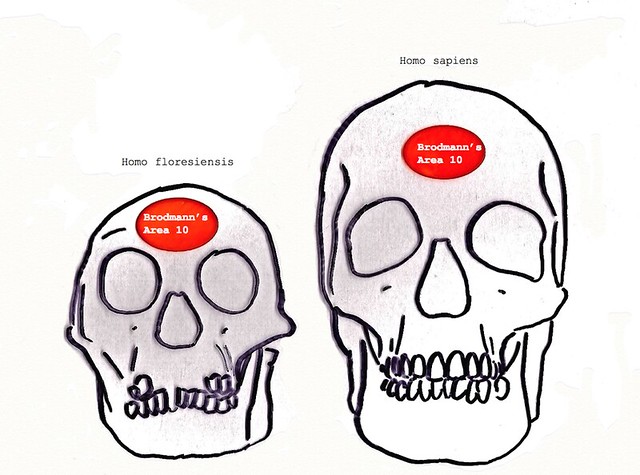Brodmann’s Area 10
September 10, 2012
Humanity’s insular dwarf Homo floresiensis, a human species that lived up until 12.000 year ago on the island of Flores, was only 100 to 110 cm tall and weighed approximately 25 kg. With its small size came a equally small brain of just 380 cm3. Modern man has an average brain size of 1250 cm3.
Although H. floresiensis’ cranial capacity is comparable to the size of chimpanzees (400 cm3) they display advanced behaviour like cooperative hunting, the use of advanced stone tools and knowledge of fire. Usually there is a strong relationship between brain size and intelligence but in the case of Homo floresiensis the way the brain is structured seems more important than its volume. An indicator of intelligence is the size of Brodmann’s area 10, a relatively unknown area of the brain associated with higher cognition and goal formation. It is remarkable that this specific brain area was of equal size in both modern humans and Homo floresiensis, despite the latter’s much smaller brain. Dean Falk, a world-renowned paleoneurologist shares the interest in H. floresiensis’s brain: “Homo floresiensis has a highly evolved brain, it didn’t get bigger, it got rewired and reorganized, and that’s very interesting.”
Interesting indeed. What will happen to the human brain if we decided to shrink even further towards the 50 cm we envision? The Incredible Shrinking Man’s brain will be as little as 25 cm3. To sustain our level of intelligence is one of the biggest challenges we face. Perhaps the reason for the relatively large size of Homo floresiensis’ Brodmann’s area 10 can help us find part of the solution.
Studies indicate that small dogs can be just as intelligent as big dogs, which have much larger brains. In addition, all three poodle sizes are second from the top in dog intelligence. This includes the toy, miniature, and standard poodles.
The African Grey Parrot has been studied at the University of Arizona. The Parrot has a walnut size brain and is considered as smart as a chimp. (Bird brains are more dense than human brains.) So with a good brain design, it appears that size doesn’t matter. Certainly smaller human brains seem to be as good as bigger ones. For example, women have 10% smaller brains but are just as smart as men. However, whether this holds true for 40% smaller human brains remains to be proven.